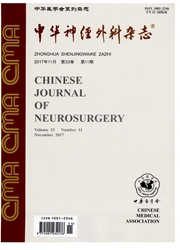

 中文摘要:
中文摘要:
目的 探讨皮质下直接电刺激(DES)在功能区弥漫性低级别胶质瘤(DLGG)切除手术中的意义.方法 回顾性分析自2010年1月至2014年5月进行手术治疗并于术中应用皮质下DES的57例大脑功能区DLGG的临床资料.结果 术中皮质下DES均能在肿瘤周边发现锥体束、丘脑上辐射或语言相关白质纤维,从而达到按功能边界切除肿瘤的目的.全切除20例(35%),次全切26例(46%),部分切除11例(19%).46例(81%)出现早期神经功能障碍,其中轻度15例(26%),中度21例(37%),重度10例(18%);4例出现晚期神经功能障碍,其中轻度3例(5%),中度1例(2%),重度0例.术前有癫痫发作的55例中,48例(87%)术后无癫痫发作;其余7例发作频率较术前减少>50%.结论 唤醒开颅下应用皮质下DES可在不降低远期生活质量的前提下最大安全切除DLGG,但早期神经功能障碍发生率高,需康复治疗.
 英文摘要:
英文摘要:
Objective To report our experience of intraoperative subcortical napping by direct electrical stimulation in surgery of diffuse low-grade gliomas in supratentorial eloquent areas.Methods We conducted a retrospective analysis of clinical data of 57 patients with diffuse low-grade gliomas who were underwent awake craniotomy with the direct electrical stinulation for subcortical mapping of the eloquent fibers.The maximal resection of the tumors and minimal damage of the eloquent fibers were the surgical goal of all patients.Results The operation was stopped by individual functional boundaries as intra-operatively identification of the cortico-spinal pathways,or superior thalamic radiation,or language-related pathways in all patients.Post-operative MRI showed that 20 patients (35%) were achieved total resection,26(46%) subtotal and 11 partial(19%).11 patients (19%) had no postoperative deficits,while 46 patients (81%) had early post-operative neurologic deficits,including 15 patients with mild neurologic deficits,21 with moderate,and 10 with severe.Four patients experienced late post-operative neurologic deficits,including 3 patients with mild deficits,1 moderate.No one experienced severe late post -operative sequelae.Among 55 patients with pre-operative epilepsy,48 patients (87%) were seizure-free with taking anti-epilepsy drugs during seven days to three months after surgery,The frequency of post-surgical seizure attack in the remaining seven patients was decreased by 50% compared with that of pre-operation.Conclusion Intraoperative subcortical mapping of the functional fibers by direct electrical stimulation under awake craniotomy allowed neurosurgeons to remove diffuse low-grade gliomas in supratentorial eloquent areas according to individual functional boundaries without increasing the late post-operative neurological deficits.However,frequent early postoperative neurological deficits often necessitated rehabilitation therapy.
 同期刊论文项目
同期刊论文项目
 同项目期刊论文
同项目期刊论文
 期刊信息
期刊信息
